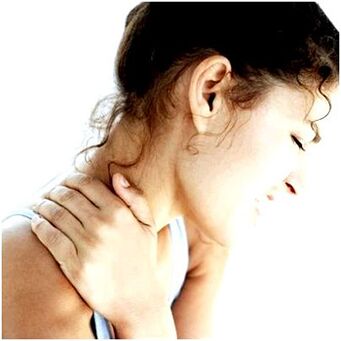
The osteocartilage process affects any spine or several at a time.The lumbar and cervical vertebrae are most affected by pathology because the anatomy of human bones is most susceptible to loading.
The consequences of spinal osteocartilage degeneration in the cervical area cause the greatest inconvenience and potential complications, as the neck is a region rich in neurologic highways, many of which feed the brain directly.
Therefore, the clinical symptoms of cervical osteochondrosis are associated with ischemia in the brain.Furthermore, when squeezed with damaged vertebrates, the nerve roots provide hand and shoulder sensitivity and motor activity, which can give a variety of symptomatic conditions.
Below, consider general clinics for cervical osteochondrosis.
Dizziness
Dizziness is also caused by invading the blood flow of the inner ear organs, thus ensuring body balance.Nystagmus often adds to dizziness - any fluctuations in the eye's pupils are to the side.
Insufficient air
This feeling occurs in stimulation at the end of the diaphragmagragmatic nerve.It is an integral part of the cervical nerve bundle, involved in the regulation of breathing, its depth and frequency.The patient complained that he could not breathe all over the chest.
In some cases, symptoms can exacerbate severe breathing and suffocation.For the same reason, breathing stops at night and exhale.
The disadvantages of oxygen caused by respiratory problems are ultimately the cause of increased fatigue, the reduction of concentration and memory problems.
nausea
It comes with the Belching Air.It is also due to blood circulation problems in certain areas of the brain and inner ear.Nausea is sometimes observed due to tenacious vomiting caused by head and body movements.The result of frequent nausea and vomiting is reduced appetite, weight loss, and digestive failure.
Vision problems
"flies" in the eyes, decreased vision, fog in front of the eyes - these are symptoms of vision due to ischemia in the brain area.
Vision in patients with osteochondrosis is less common because the lack of blood supply in the spinal canal system is compensated by blood flow from the carbon artery system.
Glasses in the eye muscles and treatment of gymnastics do not solve the problem and usually improves after treating osteochondrosis.
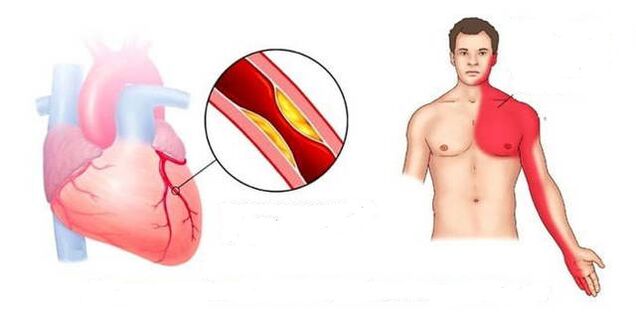
Unstable stress levels are due to impaired blood flow in the rectangular brain, resulting in the function of the vascular motor center.
It occurs in spasms of the cerebral artery due to a short-term stop of blood flow along the vertebral artery.
From a state of losing the patient's consciousness, you can quickly remove the legs by placing them, making the legs slightly higher than the head - the flow of blood to the brain allows people to prolong their lives.
After a sleepy attack, due to a brief cessation of blood flow, reversible problems of speech and movement can be observed for a period of time.
Green symptoms
Usually, this may be the only symbol indicating cervical osteochondrosis.They are expressed as a feeling of sweating, dryness and a lump in the throat, with difficulty swallowing.Symptoms are related to compression of the nerve plexus responsible for the pharyngeal nerve.It is necessary to distinguish this manifestation from similar clinics for inflammation or tumors.
The rise in body temperature in cervical osteochondrosis is not the most typical symptom, it is rarely observed locally: the skin is slightly red in the cervix and clavicle areas.
First, clinics for cervical osteochondrosis may be of varying degrees of severity, it depends on the stage of pathological development, during aggravation, they are brighter, and secondly, they form in certain syndromes.
Phase 1
The beginning of the degeneration process of vertebrae.Symptoms are weak and may sometimes be impossible to observe at all.The first sign of cervical osteochondrosis:
- Discomfort in the neck, arms, and shoulders sometimes turns into pain;
- Headache;
- It is easy to restrict neck movements;
- Fast passing visual impairment;
- Reduces the sensitivity of the skin in the clavicle area.
Important: These symptoms become more obvious when tilting the head.
Usually, in the first stage of osteochondria in the cervical area, patients do not see a doctor, believing that all symptoms are related to fatigue, stress, age, and lack of sleep.
Phase 2
At this stage, the herniation of the vertebrates begins, the vertebral cracks are narrowed, and the collagen fibers of the annular fibres of the intervertebral disc are destroyed.The obvious painful symptoms are exacerbated during movements of the neck and turns due to compression of the nerve trunk.Here, you can already suspect cervical osteochondrosis, and the symptoms of the second stage are as follows:
- There is obvious pain in the neck and sometimes tighten;
- The skin on the shoulders and hands almost completely lost sensitivity.
- Headache is common and should not pass for a long time;
- Visual impairment carries "flies" in the eyes;
- sounds and noises in the ears;
- Weaknesses in upper limb muscles;
- The clarity of tendon reflexes is reduced;
- Dedication under the blade of the shoulder;
- Feeling of a lump in the throat, swallowing problems;
- Sleep disorders, usually insomnia.
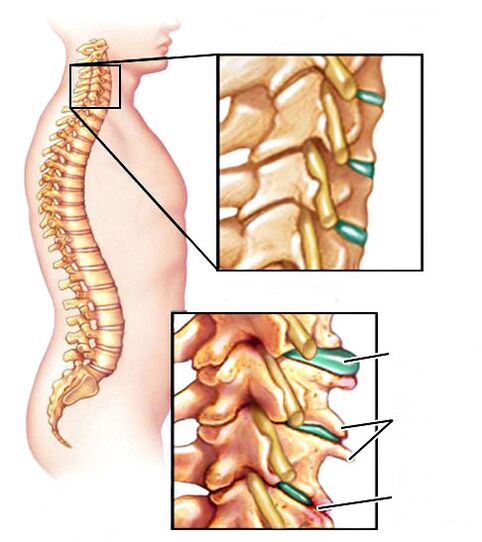
Keeping your head in one position for a long time can cause severe pain.At this stage of disease development, patients have asked doctors for help.
Stage 3
The fibrous rings in the disk are destroyed, forming a hernia.In the third stage, due to weak spinal fixation, there is deformation of the spinal displacement and dislocation.The symptoms are as follows:
- intense, acute pain in the neck, tie, heart area;
- Scalp is on the back of the head, shoulder area, and sensitivity in the hands until completely gone;
- hernia in the cervical spine;
- paralysis and paralysis of upper limbs;
- No tendency reflex was actually observed.
This is the severe stage of the disease and the patient can no longer support his head alone.Spinal ischemia and compression of spinal arteries lead to paralysis and paralysis of strokes in other parts of the body and spinal lines.
Cervical osteochondria is accompanied by the nonspecificity of osteochondria and a large number of various symptoms that make it difficult to diagnose and further treatment, as some of them may be signs of completely different diseases.Symptoms of cervical osteochondrosis develop in certain groups called syndromes.Their presence and severity may indicate the pathology of the cervical spine and have updated localization.
Clinical pictures of cervical osteochondrosis - symptoms, signs
Osteochondrosis in the cervical area is a chronic, slow-performing spinal disease in which vertebrae, vertebrae and discs are affected and damaged.The first to seventh vertebrae belonging to the cervical area were affected.
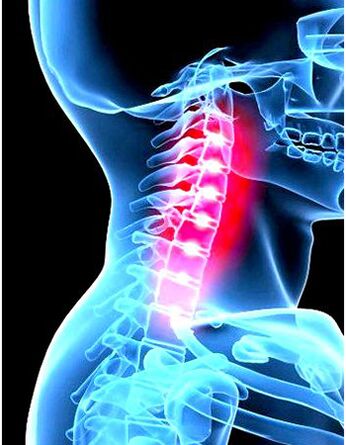
As the disease progresses, the intervertebral disc loses its elasticity and strength, flattening, relaxing, and its amortization characteristics worsen.This deformation occurs due to changes caused by power impairment and tissue depletion.
These violations are one of the natural processes of body aging, but various overloads, posture disorders, injuries, congenital abnormalities in the spine, and a number of other causes early wear and tear of the cartilage and intervertebral discs.
Pain can have different positionings, and they can be on the occipital bone, shoulders, or neck of the upper limbs.When the nerve innervates the upper limbs participate in the process, pain in the shoulder or hand occurs.Pain in the occipital bone of the head is caused by cramps in the neck muscles, which attach to the occipital bone and circulatory diseases in this area.
When symptoms occur:
- When the spine is damaged, a decrease in the sensitivity of the hand occurs, which contains sensitive nerves that innervate the skin of the upper limbs.
- Due to the decrease in the height of the intervertebral disc, the emergence of bone growth in the vertebral body and damage to the small joints between the cervical vertebral bones, the limitations of cervical vertebral movement and movement during movement occur.
- Dizziness, coordination impairment, weakness occurs in severe cases, and blood supply has a strong deterioration in the occipital supply to the brain, cerebellum and trunk.
- Language numbness, hearing and vision reduction
All these symptoms are due to the involvement of the vertebral artery in this process, which occurs in its own passageway, in the transverse process of the cervical spine.Due to the development of cervical bone cartilage, the formation of fibrous tissue, the vertebrae of the vertebrae, the blood flow in these arteries deteriorates, resulting in a deterioration of blood supply to the brain and occipital bones.
reason
- Excessive physical exercise in sports or physical labor;
- Genetic tendency;
- Hypothermia on the neck (no scarf in winter);
- pressure;
- Working on a computer;
- obesity.
Some of the above causes osteochondrosis and other spinal columns.
The degree of osteochondrosis depends on the patient's clinical condition and complaints.The concept of a degree should not be confused with the stages of osteochondrosis.The stage will be discussed below.
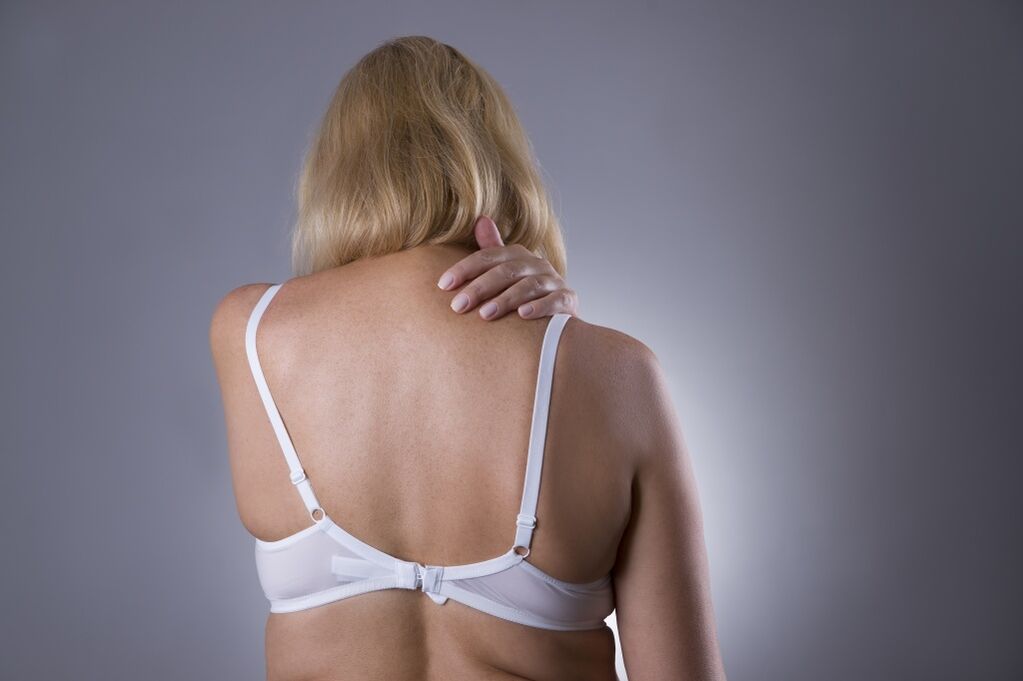
Considering and analyzing changes in vertebral tissue, doctors distinguish several stages of cervical osteochondrosis:
- Pro-oxidation halo stage.The first degree of cervical osteochondrosis is expressed by displacement of the plasmon to the lateral surface and the beginning of the fibrous annulus.During this period, pain may not exist and may be difficult in small vertebrates turning or tilting the head.
- Osteochondrosis in the second degree of cervical area is characterized by increased pathological destruction, instability throughout the segment, and pain in subluxis, sometimes radiating in the shoulder straps or arms.Patients complain about distraction, memory and attention deterioration.
- The fibrous annulus completely ruptures to form osteocartilage of 3 degrees.Neurological symptoms appear and sensitivity is disturbed.The third stage of pain becomes persistent and plagues the patient.The activity of the neck is worsened.
- Osteochondrosis on the neck is 4 degrees.The final stage of the degradation process.The disc was completely replaced by connective tissue, all symptoms became more obvious, and ataxia was recorded as exercise coordination worsened.
According to the location of the pain, the following types of diseases are distinguished: radionucleicemia, cervical cancer, cervical co-co and cervical pain.
Of course, according to this method, the disease habit is divided into acute vertebrae and osteocartilage of the neck, which first appeared and long-term, and has been ongoing for many years and has been continuously recovered and intensified.
Which doctor treats cervical osteochondrosis?
Various symptoms usually hidden under the mask of another disease can cause a logical question for the patient - which doctor should I contact?When there is any pain in the neck, shoulders and hands or neurological disorders, it is urgent to approach a neurologist or spondylosis.
If there is no such expert in the local clinic, who can I contact?In this case, the ticket should be postponed to the therapist.Doctors will prescribe treatment or send narrow specializations to their doctors.
Symptoms depend on damaged vertebrae
Additionally, radiation syndrome can be distinguished, resulting in one or the other sensitivity and movement disorders.They are different, depending on which vertebrae squeezes the spinal cord root:
- C1: Causes numbness and impaired sensitivity on the back of the head;
- C2: Pain in the top area and the back of the head;
- C3: Language disorder, language sensitivity, pain and lateral sensitivity of spinal nerve invasion;
- C4: Heart pain, lower left cartilage, shoulder blade, respiratory disease, lower tone of neck muscles;
- C5: Shoulder pain in the external area;
- C6: Pain from the forearm to the thumb of the hand, and neck with the blade of the shoulder;
- C7: Pain from the neck to the posterior surface of the shoulder blade bone, pain from the forearm to 2-4 fingers;
- C8: Pain from neck to shoulder, from forearm to small fingers.
Diagnosis of osteochondrosis
For diagnosis, instrument inspection methods were used:
- X-Spine department examination;
- Bone marrow science;
- Neurological sensitivity investigation, reflex.
Other methods prescribed for differentiation and clarification of diagnosis, pathological stages include:
- Computed tomography (CT) of the spine;
- nuclear magnetic resonance (JAMR);
- Magnetic resonance imaging (MRI).
During the examination of a neurological test, the doctor will evaluate the degree of migration and soreness of the neck, as well as impaired blood flow in the vertebral artery.
Cervical osteochondrosis requires not only the study of the vertebrae itself, but also nearby tissues, blood vessels, and nerves.Only in this way can we judge the complete situation of pathological changes that occur due to the disease.
The diagnosis of cervical osteochondrosis begins with visual examination and investigation of the patient.Neuropathologists are interested in the patient's life and labor status, chronic diseases, nutrition and exercise activities.
The preliminary diagnosis was confirmed by the conduct of instrumentation studies:
- X-rays made two predictions;
- MRI;
- CT;
- UZDS (Double-stranded Scan).
A more fairer gender requires hormone analysis.Without it, the treatment of cervical osteochondrosis in women cannot begin.
To rule out the pathology of this symptom, differential diagnosis is made by additional consultation with surgeons, gynecologists, cardiologists, ophthalmologists, and knowledge.
Complications of osteochondrosis
Osteochondrosis in the cervical spine has the risk of complications.As the disease progresses adversely, squeezing the spinal arteries may lead to stroke in the brain, and continuous deterioration of hearing and vision.
Usually it is a disc hernia, severe hypertension and numbness or finger-cooled osteocartilage.In women, complications of neurological properties often develop - persistent fatigue, lethargy, loss of manifestations, excessive resentment.
Non-compliance with prescription treatment, long-term avoidance of doctors, and lack of osteochondrosis treatment can help the development of the disease and cause the development of complications, pathology and new diseases, such as:
- Hernia of the intervertebral disc (hernia of the spine);
- protrude;
- Kyphosis;
- Radiitis;
- Salt deposits in the intervertebral space;
- Spinal cord stroke;
- Reduced muscle mass in the limbs and muscle atrophy due to impaired blood supply;
- Paralysis of the lower limbs.
Although the fourth osteochondria can occur without obvious symptoms and pain, neglected osteochondria is the most dangerous for the development of severe complications and may lead to the patient's disability.
Medical Sports
LFK for cervical osteochondrosis should be performed outside of acute exacerbation.The maximum effectiveness of this technology during recovery.There should be no discomfort and pain in the process of implementing the complex!
| Exercise 1 | Lie on your belly, place your hands on the floor, raise your head and torso, and your back should be straight.Hold in this position for 1-2 minutes.Slowly sinking into the floor.Repeat 2-3 times. |
| Exercise 2 | Lie on your belly, stretch your arms along your body, turn your head to the left, try touching the floor with your ears, and then turn your head to the right.Repeat 6-7 times in each direction. |
| Exercise 3 | In the sitting position, lean forward and try touching your chest with your head, then exhale, lean back and extend your head.Repeat 10-15 times. |
| Exercise 4 | While sitting, place your palm on your forehead, press your palm on your forehead, and your forehead on your palm.Continue this exercise for 30 seconds.Repeat 2-3 times. |
| Exercise number 5 | First, slowly rotate the head in one direction, and then rotate in the other direction.10 rotations in each direction.Make sure you don't have dizziness.When it appears, the practice stops. |
Risk factors
If anything, the chances of osteochondrosis have increased:
- abnormal spinal development;
- Too much weight;
- Long-term physical effort;
- Bad habits (smoking);
- A sedentary lifestyle;
- work, which means the periodic effect of vibration on the spine (e.g., there are vehicle drives);
- prolonged stress, excessive nerve tone;
- Local hypothermia;
- Injuries to the neck and back;
- Cartilage degeneration is required for autoimmune pathology.
psychology
The development of cervical osteochondrosis indicates incompetence.Sometimes people become so powerful and confident about their abilities that they are stable before adversity becomes rigid and lack of flexibility.In this case, attempts to turn the head are accompanied by stiffness, twitching and other unpleasant sensations.
Similarly, osteocartilage develops in people who are afraid of problems and don’t know how to deal with them.In this case, the protective reflex of the mammal is triggered and the head is actually attracted to the shoulders.Therefore, the provision is considered unnatural, and therefore, after a period of time, the muscles in the cervical area begin to be damaged and deformed.
treat
The treatment of cervical osteochondrosis depends on the stage of the disease.If there is sufficient conservative, wandering treatment in the first stage, then in the second and third stages, the doctor's task is first to stop pain syndrome.Enhanced cases may require surgical treatment for decompression and stabilization of the vertebrae.
poison
| group | describe |
| NSAIDS (Non-steroidal anti-inflammatory drug) | Helps eliminate swelling and pain.The basis of the most commonly used drugs is the action components such as diclofenac sodium. |
| Vascular Disease Drugs | Helps improve blood circulation. |
| Sedatives, muscle relaxants | In addition to promoting the general condition of the patient and reducing the NSAID dose, regulations were also prescribed.At the same time, relieve nerve transitions and muscle spasms, which helps to obtain better therapeutic effects. |
At the end of the treatment process, NSAIDs should be purchased for the home aid kit as neck pain (with stress, excessive structure, weather changes) can be restored regularly.Consult your doctor before taking any medications.
If no positive effects are observed after conservative treatment with conservative treatment, the doctor may advise the patient's spine.
This process allows you to fix the affected segment of the spine.
Its essence is to remove intervertebral discs, decompression of nerve roots, installation of implants or creation of physiological heights of intervertebral disc space.
This procedure has many side effects and contraindications.Therefore, it can lead to vertebrae disability.This is why surgery is performed in extreme cases.
Massage with cervical bone cartilage can give you significant improvements.Importantly, the procedure is performed by a professional: Incompetent movement in the cervical spine area can exacerbate this.Exercise should affect the neck band, cervical area and part of the back.
Please note that the techniques performed to treat osteochondral osteochondral osteochondral osteochondral osteochondral osteochondral osteochondral osteochondral osteochondral osteochondral osteochondral osteochondral osteochondral osteochondral osteochondral osteochondral osteochondral osteochondral osteochondral osteochond
- Feel.The masseur will affect the surface layer of the skin, moving from the upper part of the middle of the head to the upper part of the middle of the back.Meanwhile, work with your palms or fingertips.
- extrusion.Deep exposure of the skin located on the upper third of the back.In this case, the index and thumb on the neck are performed to take away the skin.Fabrics adjacent to the vertebrae do not participate in this process.
- creation.It is designed to warm the skin and increase blood flow in the clavicle area.The process must be performed with great care.Spinal processes that affect vertebrae are prohibited.Sometimes friction is replaced by circular strokes or movements similar to sawing.
- rub.It affects the deep lying fabric and is therefore of limited value.It can aggravate the pathology.
During massage, the patient should lie on the stomach, in extreme cases.
prevention

To prevent disease, it is recommended to use:
- For spinal health, it is important to sleep with pillows through orthopedic pillows and mattresses.
- Take a hot bath for 10 minutes every day;
- Visit the bathroom or sauna (relieve cramps in the neck muscles);
- Avoid sharp turns on the head;
- Walk more, do yoga and swim;
- With a “sitting” work, take a five-minute break every hour (you need to walk, tilt, and lean your body in different directions during the break);
- Avoid load increase on the spine: classes with weight, jumping, running;
- Choose chairs and chairs that support the spine;
- Give up addiction, such as smoking, alcoholism;
- Drink at least one liter of water every day.
It is recommended to eat regularly (at least five times a day) and to a small portion.Steamed or cooked dishes should be given priority.The salad needs to be seasoned with olive oil.

























